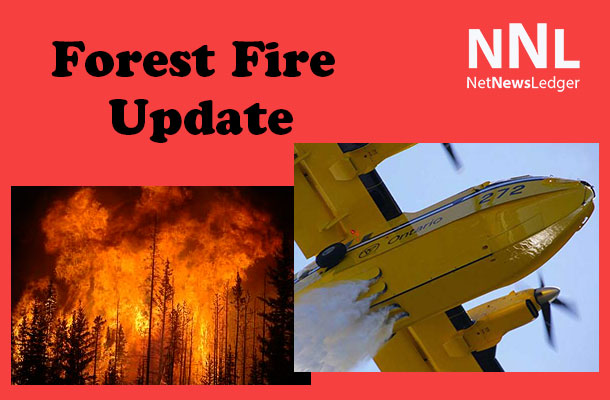
THUNDER BAY – Rain has slowed the rate of fires in the region.
There were 5 confirmed new fires by the afternoon of August 20th in the Northwest Region and 7 new fires confirmed by day’s end on August 19th. There are a total of 149 active fires in the NWR in various states of suppression as of August 20th. Scattered rainfall has assisted with suppression operations; however, fires continue to burn deep and require extensive effort by fire crews to extinguish.
Areas of concern include NIP 029, NIP 099, SLK 182 and the Big Trout Lake (KI) complex.
NIP 029, 20 km north of Nibinamik and 30 km East of Wunnumin Lake, is currently at 5998 hectares. Many of the lightning-caused fires are occurring in close proximity to each other in this area, as a result of storm systems. The Aviation, Forest Fire and Emergency Services program has established an incident management team out of Nibinamik First Nation to assist in fire suppression. On August 11th, aerial ignition specialists conducted a successful burnout operation to bring the fire’s edge out to natural boundaries. Five helicopters have been assigned to the fire and ten types 1 crews are in place establishing hose lines along the perimeter. Smoke concentrations levels are expected to remain high in the Nibinamik area over the coming days.
Due to a power outage and smoke issues a decision was made by the community to evacuate residents to the host town of Kapuskasing. The Ministry of Natural Resources and Forestry (MNRF) coordinated commercial aircraft for the evacuation. MNRF coordinates its response with the Office of the Fire Marshall and Emergency Management via the Provincial Emergency Operations Centre which continues to work with community leaders, federal departments, non-government organizations and provincial government ministries to support the community.
Nipigon District Fire Number 099 is a lightning-caused fire that started on August 12 northeast of Nipigon in the Kama Hill area. Crews have met their initial object to tie in with each other, wrapping the fire at a size of 562 hectares. An Incident Management Team is established on the fire, working out of Nipigon. There are four helicopters and fourteen Fire Ranger crews assigned to this fire. A travel advisory has been issued requesting the public’s cooperation staying off of the Camp 81 road. Fire crews, heavy equipment and air resources are currently responding to Nipigon Fire 99 in this vicinity.
Sioux Lookout District Fire Number 182 is a lightning fire 25km west of Giishkimanisiiwaaboong (Kingfisher Lake Reserve). The fire was reported August 18th at 15 hectares and has since grown to 40 hectares due to high westerly winds. An Incident Management Team has been set up to organize air attack and ground crews suppression efforts. The fire was 95% contained by the end of day on August 19th. No properties are immediately threatened at this times.
A complex of nine fires near the community of Kitchenuhmaykoosib Inninuwug (KI) are being actioned by crews under the supervision of an onsite incident management team. Of the nine fires in this complex, six have been called out, with good progress being made on the remaining three.
Other northern First Nation communities with fire management resources on site to manage fires include Deer Lake, Wunnumin Lake, Eabametoong, Neskantaga and Sandy Lake.
A fire is being monitored on Lac Seul in the Sioux Lookout District. SLK123 is being managed under the Lac Seul Conservation Reserve Fire Response Plan to restore and maintain the ecosystem on the island. This fire is within the Lac Seul Islands Conservation Reserve and is not being extinguished in order to achieve the ecological benefits of natural fire on the landscape. Signs are posted on the island alerting the public to the fire situation and advising the public to keep a safe distance away from the island until the fire has been called out and all signs have been removed. Please call the NWR Fire Information Officer @ 807-937-7335 for more information.
Sioux Lookout District Fire Number 182. Photo taken Aug. 18 showing intensity class four fire behavior. A combination of air attack and ground suppression have significantly reduced the rate of spread.
To track the fire hazards and to see a complete list of fires across the province click on our interactive map. You can also get the latest update on the condition of any fire by clicking the fire icons.
Minnesota has provided a Tactical Aircraft capable of air attack or transport as required. Three engine crews from the United States are working out of Rinker Lake to provide support to ground crews.
Travel Advisory
In order to ensure firefighter and public safety the Ministry of Natural Resources is requesting the public’s cooperation staying off of the Camp 81 road. Fire crews, heavy equipment and air resources are currently responding to Nipigon Fire 99 in this vicinity. Wildfire behavior is unpredictable, and local conditions can change very quickly. In addition to increased traffic there may be heavy smoke and reduced visibility on local roads.
Individuals travelling the Camp 81 Road may encounter closures to some spur roads (e.g. Main Road 7) to ensure safety and support fire suppression. Recreational users may want to consider alternate routes like the Lachance or Gorge Creek roads instead.
Out of Province Deployment
- Currently there are 20 staff supporting the province of British Columbia in their fire management efforts.
- Ontario continues to have firefighting staff on the ground in British Columbia to help support ongoing firefighting efforts. This is being done while also ensuring we have the necessary firefighting personnel here at home.
The public is urged to take an active role in preventing more fires. This can be done by not burning when it is windy, monitoring your fire and ensuring that you have water nearby to extinguish your fire. As a reminder, there is no day burning of brush and grass.





